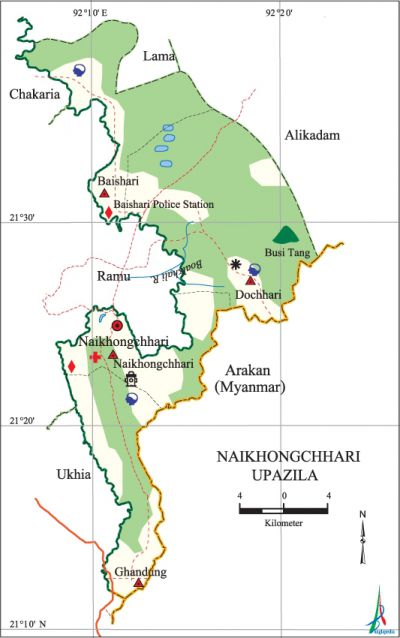Naikhongchhari Upazila
Naikhongchhari Upazila (bandarban district) area 463.61 sq km, located in between 21°11' and 21°40' north latitudes and in between 92°06' and 92°23' east longitudes. It is bounded by lama upazila on the north, arakan state of Myanmar on the south, alikadam and Arakan state of Myanmar on the east, ukhia, ramu and chakaria upazilas on the west. Busi Tang Hill of the upazila is notable.
Population Total 49465; male 26029, female 23436; Muslim 36766, Hindu 530, Buddhist 254, Christian 11523 and others 392. Indigenous communities such as chakma, marma, Murang, Tabjhong belong to this upazila.
Water bodies Main river: Boalkhali.
Administration Naikhongchhari 'Thana was formed in 1923 and it was turned into an upazila in 1985.
| Upazila | ||||||||
| Municipality | Union | Mouza | Village | Population | Density (per sq km) | Literacy rate (%) | ||
| Urban | Rural | Urban | Rural | |||||
|
-
|
4
|
17
|
226
|
14454
|
35011
|
107
|
37.6
|
30.0 |
| Upazila Town | ||||||||
|
Area (sq km) |
Mouza |
Population |
Density (per sq km) |
Literacy rate (%) | ||||
|
54.39 |
1 |
14454 |
265 |
37.62 | ||||
| Union | ||||
| Name of union and GO code | Area (acre) | Population | Literacy rate (%) | |
| Male | Female | |||
|
Ghandung 57
|
16000
|
6821
|
6321
|
28.31
|
|
Dochhari 38
|
43520
|
3081
|
2786
|
20.74
|
|
Naikhongchhari 76
|
23040
|
9894
|
8523
|
34.26
|
|
Baishari 19
|
32000
|
6233
|
5806
|
39.15 |
Source Bangladesh Population Census 2001, Bangladesh Bureau of Statistics.
History of the War of Liberation During the war of liberation in 1971 the freedom fighters established temporary camps at Tumkru Para and Sonaichhari Jhumkhola Para of the upazila. The Pak army conducted mass torture; they also set many houses of the upazila on fire.

Religious institutions Mosque 27, temple 3, church 1, math 4, keyang 29, pagoda 4, ashrama 2.
Literacy rate and educational institutions Average literacy 32.3%; male 39.4%, female 24.3%. Educational institutions: college 1, secondary school 8, primary school 47, community school 4, kindergarten 2, madrasa 4. Noted educational institutions: Saleh Ahmed Government High School, Naikhongchhari Secondary Girls' School, Naikhongchhari Model Government Primary School.
Cultural organisations Library 3, auditorium 1, theatre group 3, literary organisation 1, women's organisation 3, playground 5.
Tourists spots Upaban Tourists Centre, BLRI.
Main sources of income Agriculture 51.93%, non-agricultural labourer 13.30%, industry 0.33%, commerce 9.44%, transport and communication 1.42%, service 10.32%, construction 0.39%, religious service 0.39%, rent and remittance 0.72% and others 11.76%.
Ownership of agricultural land Landowner 43.23%, landless 56.77%; agricultural landowner: urban 40.71% and rural 44.22%.
Main crops Paddy, sugarcane, sesame, cotton, maize, rubber, tobacco, betel leaf, turmeric, ginger, vegetables.
Extinct or nearly extinct crops Barley, bajra.
Main fruits Banana, jackfruit, pine apple, lemon, papaya.
Fisheries, dairies and poultries Fishery 6, dairy 1, poultry 8.
Noted manufactories Rubber factory, tobacco factory, saw mill.
Cottage industries Weaving, wood work, bamboo work, cane work.
Hats, bazars and fairs Bahichhari Hat, Naikhongchhari Hat, Ghumdhum Hat, Baraitali Hat, Dochhari Hat.
Main exports Paddy, tobacco, rubber, banana, betel leaf, ginger.
Access to electricity All the unions of the upazila are under rural electrification net-work. However 6.28% of the dwelling households have access to electricity.
Natural resources Stone and oil mine have been detected in the upazila.
Sources of drinking water Tube-well 54.28%, tap 0.49%, pond 8.54% and others 36.70%.
Sanitation 8.48% (rural 3.91% and urban 20.04%) of dwelling households of the upazila use sanitary latrines and 54.07% (rural 56.87% and urban 46.98%) of dwelling households use non-sanitary latrines; 37.45% of households do not have latrine facilities.
Health centres Upazila health complex 1, union health and family welfare centre 2, veterinary hospital 1.
NGO activities Operationally important NGOs is brac. [Atikur Rahman]
References Bangladesh Population Census 2001, Bangladesh Bureau of Statistics; Cultural survey report of Naikhongchhari Upazila 2007.
